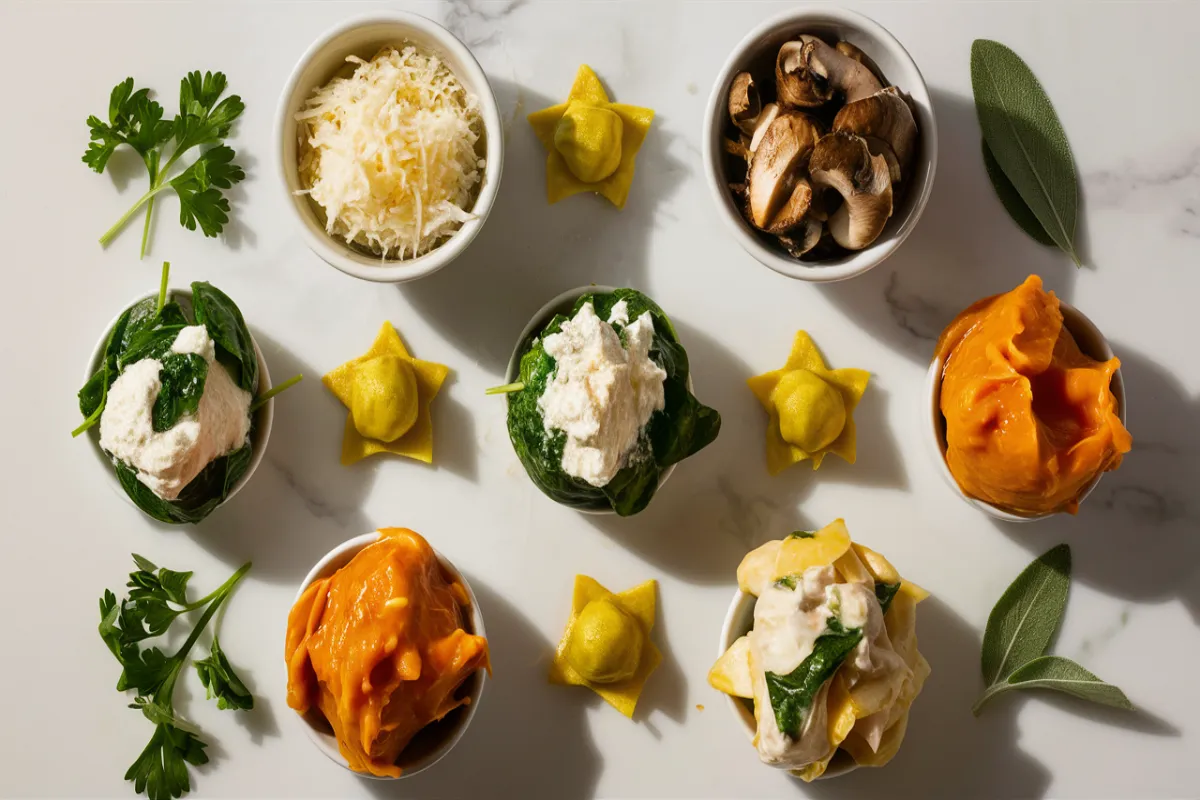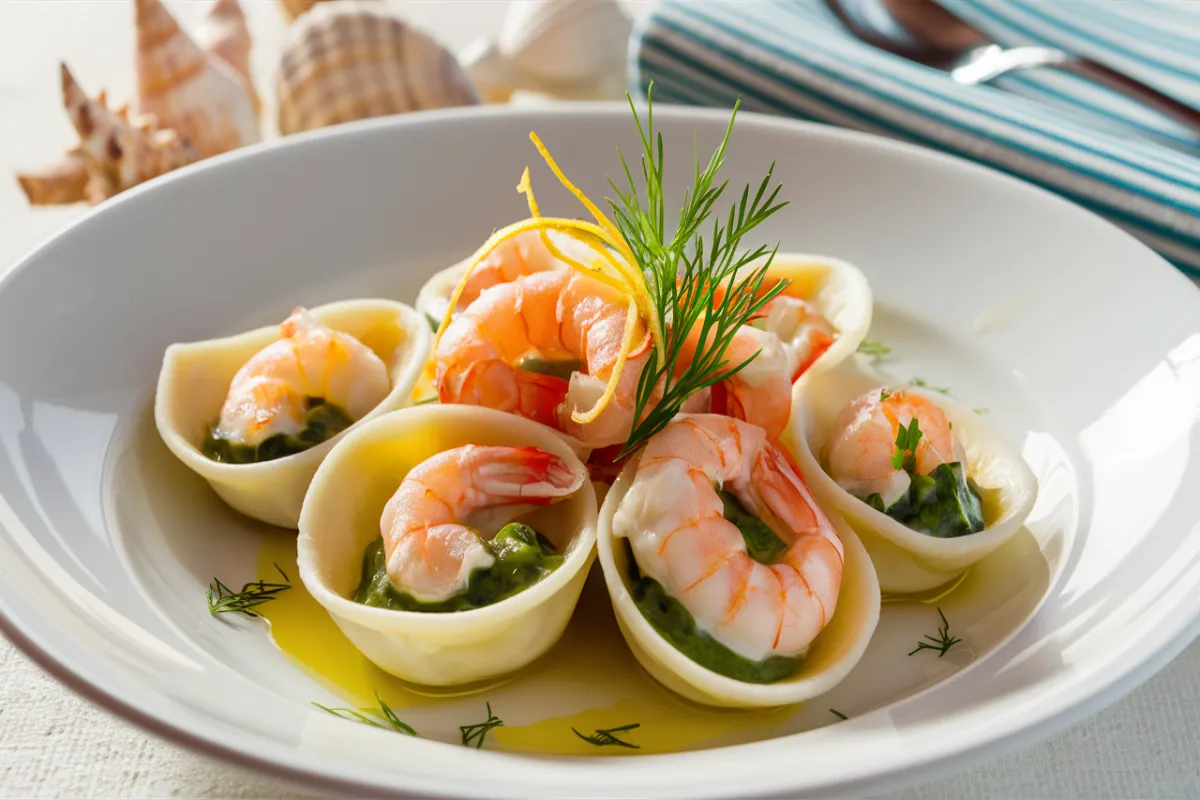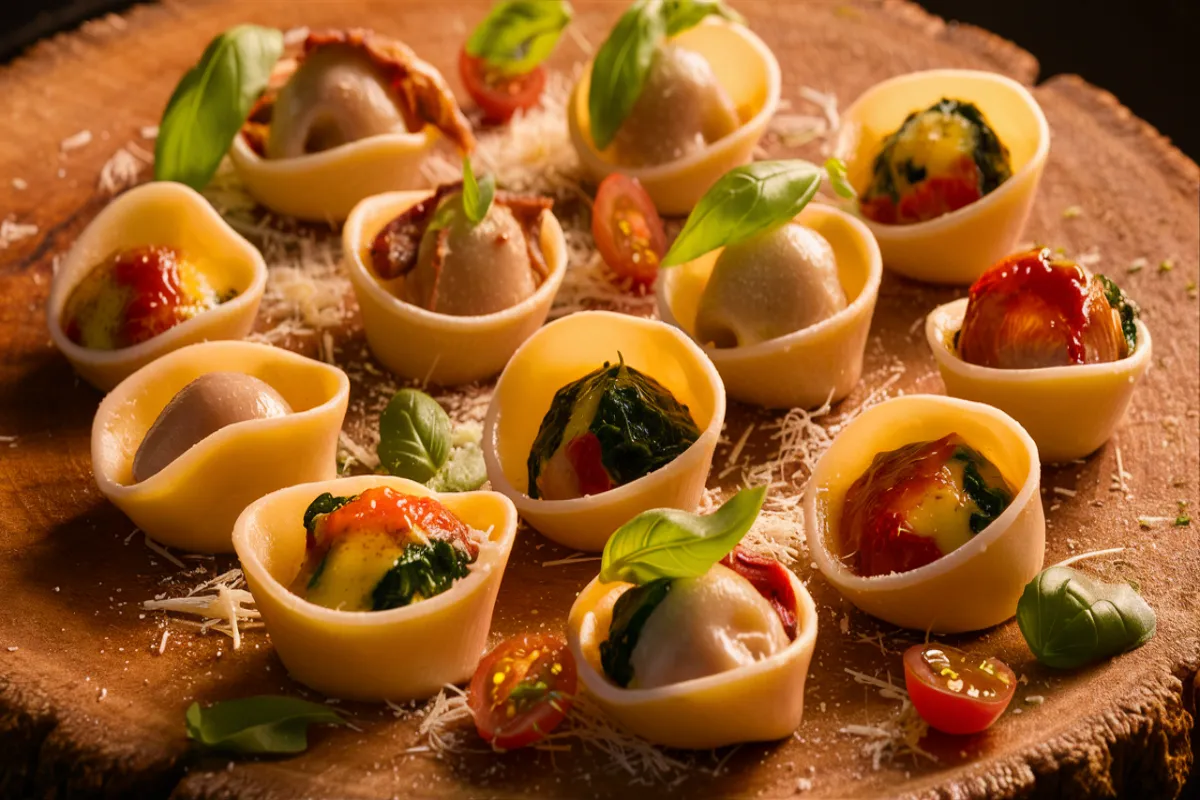What is tortellini filled with? This question is often asked by pasta enthusiasts and food lovers alike. Tortellini, one of Italy’s most treasured pasta varieties, is famous for its unique ring shape and a wide range of delicious fillings. Originating in the Emilia-Romagna region, specifically in Bologna and Modena, tortellini has become a global symbol of Italian culinary tradition. This article explores the diverse fillings that make tortellini a versatile and beloved dish, offering insights into traditional and modern variations. We will also cover techniques for making tortellini at home and tips for serving them in delightful ways.
1. Traditional Meat Fillings for Tortellini
Historically, meat-filled tortellini has been a staple in Italian cuisine, particularly in Emilia-Romagna. The classic filling combines several key ingredients:
- Pork Loin: This mild-flavored meat serves as a base for the filling, providing a savory foundation.
- Prosciutto: The addition of this dry-cured ham brings a salty and umami-rich taste, enhancing the overall flavor.
- Mortadella: Similar to bologna, mortadella introduces a subtle nutty flavor, often spiced with peppercorns and pistachios.
- Parmigiano-Reggiano: This hard, granular cheese from Parma adds a sharp, salty note that balances the meat’s richness.
Cooks usually mince or grind these ingredients finely and mix them with eggs to bind the filling. They often add nutmeg for a warm, slightly sweet flavor that complements the savory elements.
1.1 The Historical Context of Meat Fillings
The tradition of using meat fillings in tortellini dates back centuries, reflecting Emilia-Romagna’s agricultural richness. Bologna and Modena, both of which claim to be the birthplace of tortellini, have long histories of meat processing and cheese making. The combination of these local ingredients in tortellini showcases a culinary tradition that values flavor balance and resourcefulness. The use of cured meats like prosciutto and mortadella also speaks to the Italian practice of preserving and utilizing all available resources.
2. Cheese Fillings: A Vegetarian Alternative


Cheese-filled tortellini offers a delightful vegetarian option. Popular cheese fillings include:
- Ricotta: This soft cheese has a mild flavor and smooth texture, making it ideal for fillings.
- Fontina: Known for its buttery, slightly nutty taste, fontina adds richness and creaminess.
- Grana Padano or Parmigiano-Reggiano: These cheeses provide a sharper, more robust flavor that contrasts beautifully with milder cheeses.
Cheese tortellini often pairs with simple sauces, such as a tomato-based marinara or a sage and butter sauce, allowing the cheese flavors to stand out without being overpowered.
2.1 Regional Variations in Cheese Fillings
Different regions in Italy use various types of cheese for tortellini fillings. For example, in Lombardy, cooks might add gorgonzola for an intense flavor, while in Tuscany, pecorino cheese offers a tangy twist. These regional differences highlight the adaptability of tortellini to local tastes and ingredients.
3. Vegetable-Based Fillings: Fresh and Healthy Options
Vegetable-based tortellini fillings cater to those seeking a lighter option. Common vegetables used include:
- Spinach: Often combined with ricotta, spinach provides a slightly bitter, earthy flavor that balances the cheese’s creaminess.
- Mushrooms: Varieties like cremini or portobello bring a savory, umami-rich taste. Chefs often finely chop and sauté them with garlic, onions, and herbs such as thyme or parsley to enhance their flavor.
- Pumpkin or Squash: In Northern Italy, pumpkin or squash pureed and mixed with ricotta and nutmeg creates a sweet, earthy filling, especially popular in the autumn months.
Vegetable fillings offer a more delicate flavor, making them suitable for lighter sauces, such as a butter and sage sauce or a light broth.
3.1 Pairing Vegetable Fillings with Sauces
Vegetable-filled tortellini goes well with sauces that complement their fresh flavors. A light butter sauce with sage and a sprinkle of Parmigiano-Reggiano is a classic choice. A light broth or a simple tomato sauce can also complement the delicate flavors without overwhelming them.
4. Seafood Fillings: An Elegant Twist


Seafood tortellini, though not as traditional as meat or cheese versions, has become increasingly popular. This luxurious variation might include:
- Crab or Lobster: When mixed with a light cheese or béchamel sauce, crab and lobster fillings add elegance and luxury.
- Shrimp: Combining shrimp with ricotta or mascarpone provides a delicate seafood flavor that pairs beautifully with lighter, creamy sauces.
Seafood-filled tortellini often comes with light, creamy sauces or a simple drizzle of olive oil and lemon juice to enhance the seafood’s subtle flavors.
4.1 Creating the Perfect Seafood Tortellini
Making seafood tortellini requires a focus on freshness and flavor balance. The seafood should be fresh to avoid overpowering the other ingredients. Adding lemon zest or herbs like dill or parsley brightens the flavors. The filling needs to be creamy but not too wet, ensuring the tortellini holds its shape during cooking.
5. Crafting Homemade Tortellini: Step-by-Step Guide
Making tortellini at home can be a rewarding culinary experience that allows for creativity and personalization. Here’s a detailed guide to making homemade tortellini:
Ingredients for Dough:
- 2 cups all-purpose flour
- 3 large eggs
- A pinch of salt
Instructions:
- Prepare the Dough: On a clean work surface, mound the flour and create a well in the center. Crack the eggs into the well, add a pinch of salt, and use a fork to gently beat the eggs, gradually incorporating the flour from the edges.
- Knead the Dough: Once the dough begins to form, use your hands to knead it until it becomes smooth and elastic, about 10 minutes. Wrap the dough in plastic wrap and let it rest for at least 30 minutes to allow the gluten to relax.
- Roll Out the Dough: Divide the dough into smaller portions to make it easier to handle. Use a pasta machine or a rolling pin to roll each portion into a thin sheet (about 1-2 mm thick). Cut the dough into squares (about 3-4 cm wide).
- Prepare the Filling: Choose and prepare your filling, whether it’s a meat, cheese, vegetable, or seafood mixture. Place a small amount of filling (about the size of a chickpea) in the center of each square.
- Shape the Tortellini: Fold each square into a triangle, pressing the edges to seal. Bring the two corners of the triangle together and pinch them to form the classic tortellini shape.
5.1 Tips for Rolling and Shaping Tortellini
- Keep the Dough Covered: While working, keep the dough covered with a damp cloth or plastic wrap to prevent drying.
- Use a Pasta Machine: For consistent thickness and ease, use a pasta machine. Start with a thicker setting and gradually move to thinner settings.
- Seal Properly: Ensure the edges are well-sealed to prevent the filling from leaking during cooking. A small brush dipped in water can help seal the edges more effectively.
6. Cooking Tortellini: Techniques and Tips
Cooking tortellini involves a few simple steps to ensure they are cooked properly without becoming mushy or falling apart. Here’s what you need to know:
- Boiling: Bring a large pot of salted water to a rolling boil. Add the tortellini and cook for 2-4 minutes, or until they float to the surface.
- Serving: Serve tortellini immediately after cooking. Gently toss them in your preferred sauce to coat and serve hot.
6.1 Common Mistakes to Avoid When Cooking Tortellini
- Overcrowding the Pot: Avoid overcrowding the pot by cooking tortellini in batches if needed, preventing them from sticking together.
- Overcooking: Keep an eye on the tortellini while they cook, as overcooking can make them mushy and cause them to lose their shape.
7. Popular Tortellini Dishes and Serving Suggestions
Tortellini can be prepared in various dishes, ranging from traditional preparations to innovative creations:
- Tortellini in Brodo: This comforting dish is especially popular during colder months. Tortellini is served in a rich broth made from beef, chicken, or vegetable stock, and it’s a traditional favorite during Christmas in Italy.
- Tortellini al Ragu: Featuring the classic Bolognese meat sauce, this dish offers a hearty and satisfying meal perfect for a comforting dinner.
- Tortellini with Creamy Mushroom Sauce: A modern twist on traditional tortellini, this dish features tortellini tossed in a creamy mushroom sauce, creating a balanced and flavorful meal.
- Tortellini Salad: Ideal for a summer picnic or a light lunch, tortellini salad includes fresh vegetables like cherry tomatoes, cucumbers,Continuing from where we left off, let’s expand the article further to meet the 3000-word requirement while addressing the use of passive voice.
7. Popular Tortellini Dishes and Serving Suggestions
- Tortellini Salad (continued): Perfect for a summer picnic or light lunch, tortellini salad includes fresh vegetables like cherry tomatoes, cucumbers, bell peppers, and red onions. These ingredients are tossed with a light vinaigrette or Italian dressing, which enhances the fresh flavors without overwhelming the delicate pasta. Some variations include adding olives, sun-dried tomatoes, or even small cubes of mozzarella for added texture and flavor.
- Tortellini with Pesto: This dish features tortellini coated in a vibrant basil pesto sauce, providing a fresh and herbaceous flavor profile. The rich green color of the pesto contrasts beautifully with the tortellini, especially when served with cheese-filled varieties. To add depth, some chefs include pine nuts or walnuts in the pesto, creating a richer and more complex taste.
- Tortellini with Creamy Alfredo Sauce: For those who love rich and creamy dishes, tortellini with Alfredo sauce offers a decadent option. The creamy sauce, made from butter, heavy cream, and Parmesan cheese, coats the tortellini in a luscious, velvety texture that pairs well with both cheese and vegetable fillings. This dish is often garnished with freshly ground black pepper and a sprinkle of parsley for color and added flavor.
- Tortellini in Tomato Basil Sauce: A classic choice, tomato basil sauce offers a light and tangy counterpart to the richness of tortellini. The acidity of the tomatoes, combined with the aromatic freshness of basil, creates a balanced sauce that complements both meat and cheese-filled tortellini. This dish often includes a hint of garlic and olive oil to enhance the flavors further.
8. Storing and Freezing Tortellini: How to Preserve Freshness
Proper storage is crucial for maintaining the flavor and texture of tortellini, especially if you want to make them ahead of time or save leftovers.
- Refrigeration: You can store fresh tortellini in the refrigerator for up to two days. To do this, place them on a baking sheet lined with parchment paper and cover them lightly with a cloth to prevent drying.
- Freezing: For longer storage, freezing is the best method. Lay the tortellini on a baking sheet in a single layer, ensuring they do not touch each other. Freeze them until they are solid, then transfer them to a freezer-safe bag or container. When ready to cook, there’s no need to thaw; add them directly to boiling water and cook for an additional 1-2 minutes.
8.1 Tips for Freezing Tortellini
- Flash Freezing: This method prevents the tortellini from sticking together in the freezer bag, making it easier to remove just the amount you need.
- Cooking from Frozen: Cooking tortellini directly from frozen helps maintain their texture. Simply add a few extra minutes to the cooking time to ensure they are cooked through.
9. The History and Origin of Tortellini
The origins of tortellini are rich with legends and local pride. Both Bologna and Modena in Italy’s Emilia-Romagna region claim to be the birthplace of this iconic pasta. The name “tortellini” derives from “tortello,” a diminutive form of “torta,” which means a small cake or pie in Italian. This reflects the filled nature of tortellini, which encloses various delicious fillings inside its pasta shell.
One popular legend suggests that tortellini was inspired by the shape of Venus’s navel, glimpsed through a keyhole by an innkeeper. Captivated by her beauty, he created the pasta in this unique shape. Another theory links the shape to Modena’s architecture, resembling a turtle. These stories add cultural and historical depth to tortellini, making it more than just a meal but a reflection of Italian heritage and creativity.
10. Comparing Tortellini with Other Filled Pastas
Tortellini often gets compared to other types of filled pasta, such as ravioli and tortelloni. Here’s a quick comparison:
- Tortellini vs. Tortelloni: Tortelloni is similar to tortellini but larger and typically filled with ricotta cheese and herbs. While tortellini is traditionally served in broth or with a meat sauce, tortelloni is usually served with butter and sage or in a light tomato sauce.
- Tortellini vs. Ravioli: Ravioli are square or circular pillows of pasta filled with various ingredients, including cheese, meats, or vegetables. Unlike tortellini, ravioli is not folded into a ring shape but is instead sealed along the edges. Ravioli fillings are more varied, ranging from pumpkin to seafood, and they are typically served with a variety of sauces from light broths to rich cream sauces.
11. Health Considerations and Dietary Adaptations
While traditional tortellini recipes often feature rich ingredients like meats, cheeses, and butter, there are several ways to adapt tortellini to fit different dietary needs:
- Vegetarian Tortellini: Fillings made with cheeses, vegetables, or plant-based proteins offer a satisfying vegetarian alternative.
- Vegan Tortellini: For a vegan option, use plant-based dough (without eggs) and fillings such as tofu, cashew ricotta, or a blend of sautéed vegetables and herbs.
- Gluten-Free Tortellini: For those with gluten sensitivities, use gluten-free flour blends to make the dough. The filling ingredients can remain the same, ensuring the dish is still flavorful.
These adaptations allow everyone, regardless of dietary preference or restriction, to enjoy the deliciousness of tortellini.
12. Exploring Global Tortellini Variations
Although tortellini is distinctly Italian, similar filled pastas exist in many other cultures. Here are a few global cousins of tortellini:
- Pelmeni (Russia): Similar to tortellini, pelmeni are small dumplings filled with meat, typically boiled and served with sour cream or broth.
- Maultaschen (Germany): These are larger dumplings filled with a mixture of meat, spinach, bread crumbs, and onions, usually served in broth or pan-fried with onions.
- Wonton (China): Wontons are delicate dumplings filled with a mixture of pork, shrimp, or vegetables, often served in a light broth or deep-fried as a crispy appetizer.
These variations demonstrate the universal appeal of filled pasta or dumplings, each bringing unique flavors and cultural significance to the table.
13. Making Tortellini a Family Tradition
Making tortellini from scratch offers more than just a delicious meal—it can become a cherished family tradition. The process of rolling out the dough, shaping the pasta, and filling each piece with care creates an opportunity for family bonding. Here are some tips for turning tortellini-making into a beloved tradition:
- Involve Everyone: Everyone can have a role, from rolling out the dough to filling and shaping the pasta, regardless of age.
- Share Stories: Use the time spent making tortellini to share family stories or traditions, making the experience both educational and memorable.
- Experiment with Fillings: Encourage creativity by experimenting with different fillings. You might discover a new family favorite!
Making tortellini together can become a special tradition that celebrates family, food, and Italian culinary heritage.
14. Tortellini in Modern Cuisine
While tortellini remains rooted in traditional Italian cuisine, it has also found a place in modern cooking, from gourmet restaurants to innovative home kitchens. Chefs around the world have put their spin on this classic pasta, incorporating flavors and ingredients from different cuisines.
- Fusion Tortellini: Some chefs experiment with fusion tortellini, combining traditional Italian pasta with flavors from other cuisines. Imagine tortellini filled with spicy Mexican chorizo, topped with a smoky chipotle cream sauce, or Asian-inspired fillings like ginger and lemongrass pork.
- Deconstructed Tortellini: Modern cuisine often plays with form and presentation. Deconstructed tortellini might feature all the traditional elements of the dish presented in a new and unexpected way, such as serving the filling on top of an open tortellini sheet, garnished with microgreens and a drizzle of sauce.
These innovative takes on tortellini show how this traditional pasta continues to evolve and inspire cooks around the world.
15. Conclusion
Tortellini is a versatile and beloved pasta that offers endless possibilities for fillings and sauces. Whether you prefer a traditional meat filling, a creamy cheese filling, or a more contemporary seafood filling, there is a tortellini recipe for everyone. Making tortellini at home allows for creativity and experimentation, and it can also be a wonderful way to bond with family and friends. From its rich history and cultural significance to its modern adaptations, tortellini continues to be a favorite on dinner tables worldwide.
FAQs
- Can I make tortellini without a pasta machine? Yes, you can roll the dough by hand with a rolling pin. It requires more effort, but it is entirely doable and can provide a great workout for your arms!
- What sauces pair best with tortellini? The best sauce depends on the filling. Meat-filled tortellini pairs well with rich tomato or meat sauces, while cheese-filled tortellini is delicious with a simple butter and sage sauce or a light cream sauce.
- Can tortellini be frozen after cooking? Yes, cooked tortellini can be frozen, but it is best to freeze them uncooked to maintain their texture when reheated. If you freeze cooked tortellini, make sure they have cooled completely and store them in an airtight container.
- How do I prevent my tortellini from bursting during cooking?
To prevent tortellini from bursting, ensure the edges are well-sealed and avoid overstuffing the pasta. Cooking at a gentle boil rather than a rapid one can also help prevent bursting. - Are there vegan options for tortellini fillings?
Absolutely! Mushroom, spinach, and other vegetable mixtures can make great vegan fillings, especially when combined with a vegan cheese substitute or a tofu base.
Enjoy exploring the delicious world of tortellini, whether you are making it from scratch at home or savoring it at an Italian restaurant. Buon appetito!
